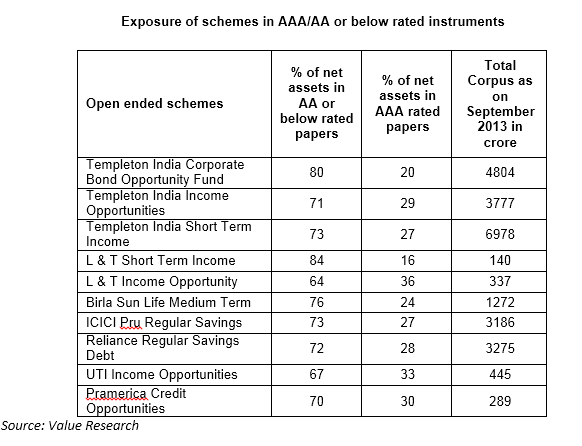Seven fund houses have exposure of more than 60 percent of their net assets in AA rated papers.
To benefit from yield pick-up in AA and below rated papers, some fund houses have increased their exposure to AA rated or below rated debt instruments, particularly in their open ended schemes.
Value Research data shows that open ended debt funds have exposure of 53% of net assets in AA or below rated papers. Further, ten open ended debt schemes have exposure of more than 60% of their net assets in such papers. As a whole, industry has exposure of more than 22% in these papers with Rs. 43,189 crore as on July 31, 2013. The data also shows that income funds have highest allocation to these papers with Rs. 26000 crore or 20% of total assets whereas short term funds have exposure of Rs. 17,041 crore or 30% of net assets.
Among income funds, Franklin Templeton India Corporate Bond Fund which has delivered an absolute return of 8.33% has an exposure of 80% in AA and below rated papers. L&T Short Term Fund has a exposure of 84% in such papers. The scheme has also given a decent absolute return of 7.54% over a one year period.

Dhruva Raj Chatterji, Senior Investment Consultant, Morningstar India says that some fund houses follow this strategy on back of their extensive research team in order to chase higher yields. However, current economic scenario may not permit this strategy since risk of credit downgrade is looming large over the country, he adds.
A senior fund manager from one of the fund houses believes it as a risky bet for the portfolio. He says its better off to invest in AAA rated papers since it reduces credit as well as interest risks.
Vijay Mantri, CEO, Pramerica Mutual Fund says, “Credit rating is just a starting point of choosing a debt instrument. One should keep in mind other factors like short term rating, viability, brand name and reliability of a company while investing in debt instruments. There are many big corporate names in AA or low rated papers like State Bank of Hyderabad, Tata Tele, Shriram Transport, HPCL etc. Pramerica Credit Opportunity Fund has invested in these papers after thorough analysis and research. This helps us benefit from yield pick-up in a low rated paper.”
Raghav Iyengar, ICICI Prudential, EVP & Head – Retail and Institutional Business says, “While taking exposure to AA rated credit rated paper we follow rigorous research on the qualitative and quantitative parameters of the company and its business environment. These investments in AA rated papers are cherry picked from amongst a large number of similar credit rated borrowers. As a policy we do not invest in below investment grade and any exposure to unrated papers will require the credit to get a high internal credit rating. In past one year, the fund has maintained average 56% exposure to AA papers with a view to generate reasonable returns. On an average, the exposure to highest rated papers AAA/A1+ stood at 25% over the past year.”
Nikhil Kothari of Etica Wealth Management believes that these open ended debt schemes usually come with high exit loads so that fund managers can hold such papers at least for 2 to 3 years to ensure better returns to investors. According to him, these funds can perform better if redemption pressure is low. He says, “For last three years, AA and below rated funds have accrued good returns and in long term these papers pay off well to investors. Investors need to consider viability of a fund house to cope up with credit risks.”


